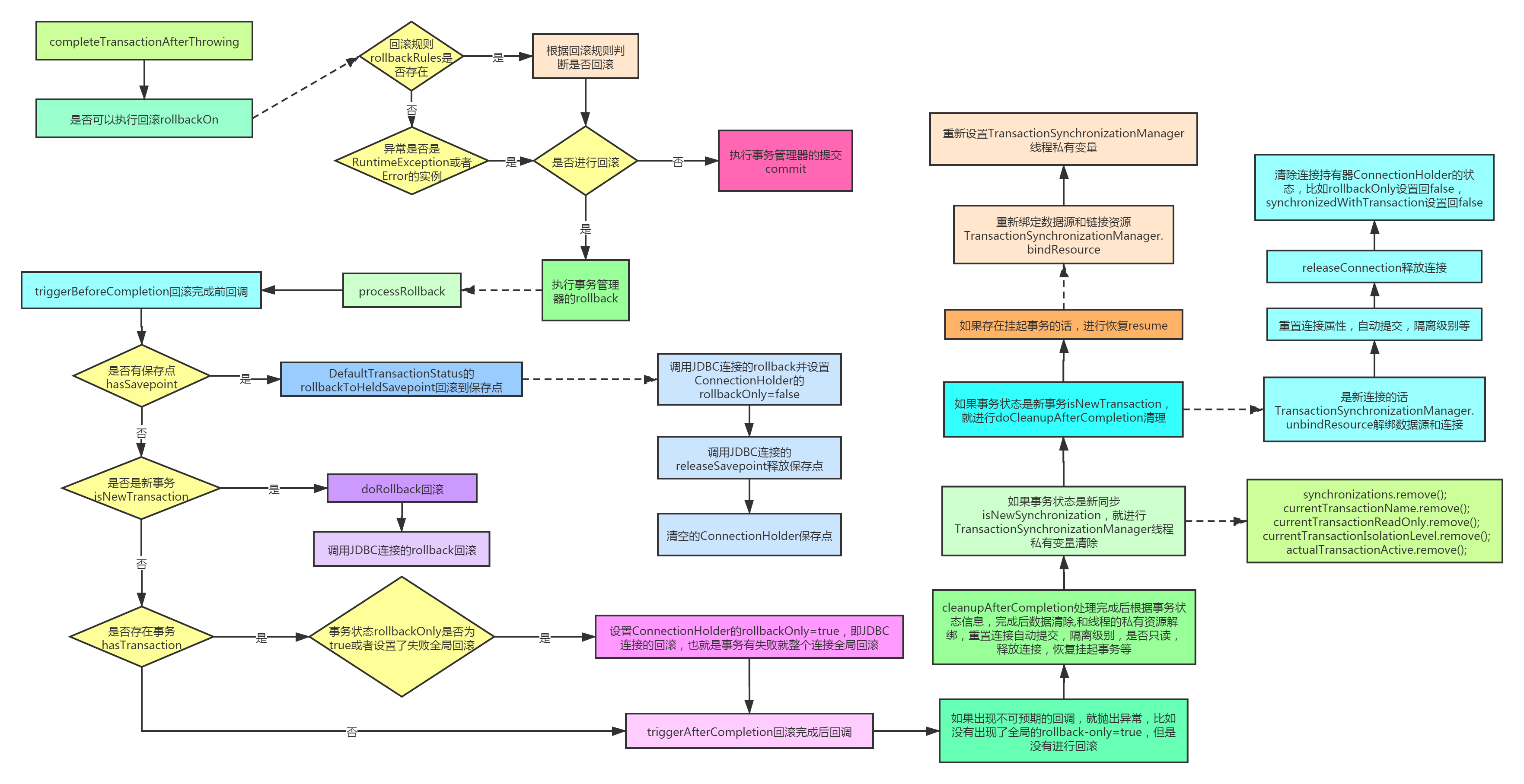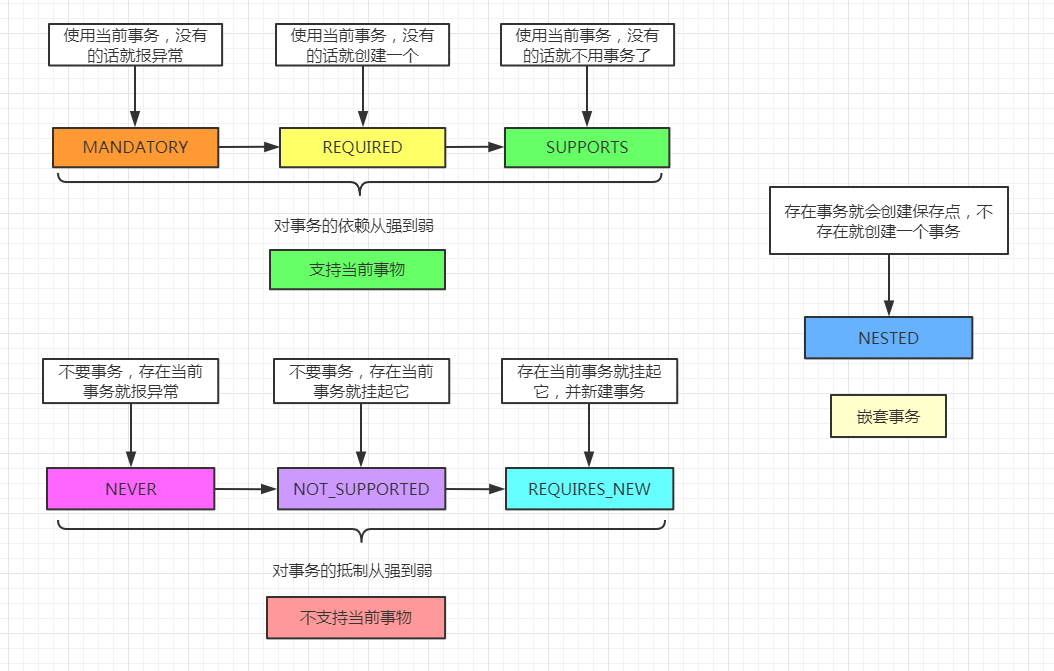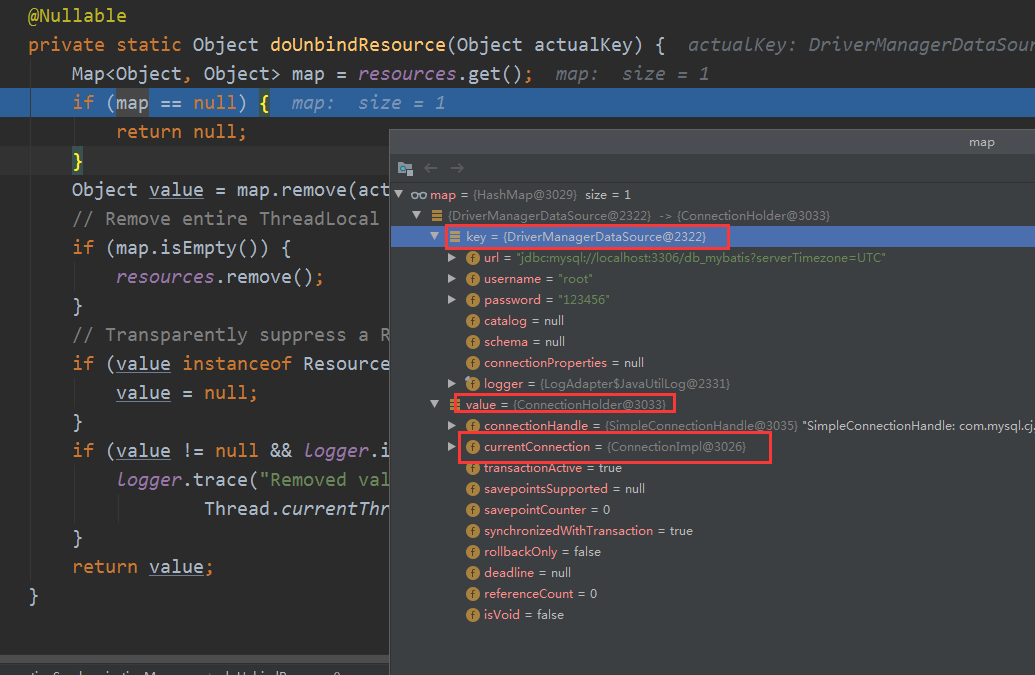- 处理回滚流程图
- 传播机制图
- AbstractPlatformTransactionManager的cleanupAfterCompletion回滚后处理
-
- TransactionSynchronizationManager的clear清除同步状态
- DataSourceTransactionManager的doCleanupAfterCompletion清除连接相关操作
- TransactionSynchronizationManager的unbindResource解绑数据源
- DataSourceUtils的resetConnectionAfterTransaction重置连接
- DataSourceUtils的releaseConnection释放连接
-
- doReleaseConnection释放连接
-
- doCloseConnection关闭连接
处理回滚流程图

传播机制图

AbstractPlatformTransactionManager的cleanupAfterCompletion回滚后处理
看上去很像没多少东西,其实里面涉及好多呢,比如如果是新的事务同步状态的话,要把线程的同步状态清除了,如果是新事务的话,进行数据清除,线程的私有资源解绑,重置连接自动提交,隔离级别,是否只读,释放连接等。如果有挂起的事务,还要把这个事务给恢复,其实就是把属性设置回去。
private void cleanupAfterCompletion(DefaultTransactionStatus status) {
status.setCompleted();
if (status.isNewSynchronization()) {
TransactionSynchronizationManager.clear();//线程同步状态清除
}
if (status.isNewTransaction()) {
//是新事务的话,进行数据清除,线程的私有资源解绑,重置连接自动提交,隔离级别,是否只读,释放连接等
doCleanupAfterCompletion(status.getTransaction());
}
if (status.getSuspendedResources() != null) {
//有挂起的事务要恢复
if (status.isDebug()) {
logger.debug("Resuming suspended transaction after completion of inner transaction");
}
Object transaction = (status.hasTransaction() ? status.getTransaction() : null);
resume(transaction, (SuspendedResourcesHolder) status.getSuspendedResources());
}
}
TransactionSynchronizationManager的clear清除同步状态
就是前面我们设置的线程私有的一些属性。
public static void clear() {
synchronizations.remove();
currentTransactionName.remove();
currentTransactionReadOnly.remove();
currentTransactionIsolationLevel.remove();
actualTransactionActive.remove();
}
DataSourceTransactionManager的doCleanupAfterCompletion清除连接相关操作
这里就是做跟连接相关的操作,比如重置自动提交啊,只读属性啊,解绑数据源啊,释放连接啊,清除链接持有器属性啊。
@Override
protected void doCleanupAfterCompletion(Object transaction) {
DataSourceTransactionObject txObject = (DataSourceTransactionObject) transaction;
// Remove the connection holder from the thread, if exposed.
if (txObject.isNewConnectionHolder()) {
//接触数据源和连接的绑定
TransactionSynchronizationManager.unbindResource(obtainDataSource());
}
// Reset connection.
Connection con = txObject.getConnectionHolder().getConnection();
try {
if (txObject.isMustRestoreAutoCommit()) {
con.setAutoCommit(true);//充实连接自动提交属性
}
DataSourceUtils.resetConnectionAfterTransaction(//重置隔离级别,是否只读等
con, txObject.getPreviousIsolationLevel(), txObject.isReadOnly());
}
catch (Throwable ex) {
logger.debug("Could not reset JDBC Connection after transaction", ex);
}
if (txObject.isNewConnectionHolder()) {
if (logger.isDebugEnabled()) {
logger.debug("Releasing JDBC Connection [" + con + "] after transaction");
}
DataSourceUtils.releaseConnection(con, this.dataSource);//释放连接
}
//连接持有器属性清除
txObject.getConnectionHolder().clear();
}
TransactionSynchronizationManager的unbindResource解绑数据源
public static Object unbindResource(Object key) throws IllegalStateException {
//获取数据源
Object actualKey = TransactionSynchronizationUtils.unwrapResourceIfNecessary(key);
Object value = doUnbindResource(actualKey);//获取解绑的连接持有器
if (value == null) {
throw new IllegalStateException(
"No value for key [" + actualKey + "] bound to thread [" + Thread.currentThread().getName() + "]");
}
return value;
}
其实就是从线程私有变量resources中删除了,这个是个map,因为可能有多个数据源绑定多个连接的。

DataSourceUtils的resetConnectionAfterTransaction重置连接
其实就是重置事务隔离状态和是否只读。
public static void resetConnectionAfterTransaction(
Connection con, @Nullable Integer previousIsolationLevel, boolean resetReadOnly) {
...
try {
if (previousIsolationLevel != null) {
...
con.setTransactionIsolation(previousIsolationLevel);
}
if (resetReadOnly) {
...
con.setReadOnly(false);
}
}
catch (Throwable ex) {
logger.debug("Could not reset JDBC Connection after transaction", ex);
}
}
DataSourceUtils的releaseConnection释放连接
释放JDBC连接。
public static void releaseConnection(@Nullable Connection con, @Nullable DataSource dataSource) {
try {
doReleaseConnection(con, dataSource);
}
catch (SQLException ex) {
logger.debug("Could not close JDBC Connection", ex);
}
catch (Throwable ex) {
logger.debug("Unexpected exception on closing JDBC Connection", ex);
}
}
doReleaseConnection释放连接
获取连接持有器,释放连接,然后关闭连接。
public static void doReleaseConnection(@Nullable Connection con, @Nullable DataSource dataSource) throws SQLException {
if (con == null) {
return;
}
if (dataSource != null) {
ConnectionHolder conHolder = (ConnectionHolder) TransactionSynchronizationManager.getResource(dataSource);//获取连接持有器,如果前面解除绑定非就拿不到了
if (conHolder != null && connectionEquals(conHolder, con)) {
//如果连接持有器能拿到的话
// It's the transactional Connection: Don't close it.
conHolder.released();
return;
}
}
doCloseConnection(con, dataSource);//关闭连接
}
doCloseConnection关闭连接
如果不是SmartDataSource类型就关闭连接了。
public static void doCloseConnection(Connection con, @Nullable DataSource dataSource) throws SQLException {
if (!(dataSource instanceof SmartDataSource) || ((SmartDataSource) dataSource).shouldClose(con)) {
con.close();
}
}
好了,今天就到这里了,希望对学习理解有帮助,大神看见勿喷,仅为自己的学习理解,能力有限,请多包涵。